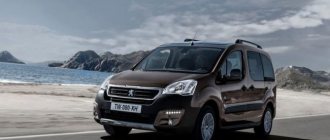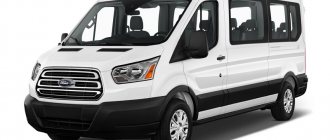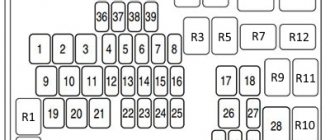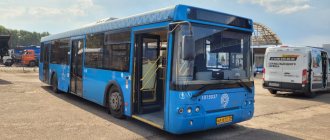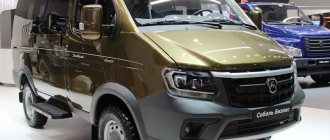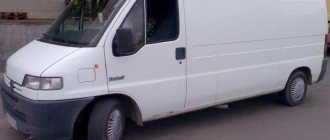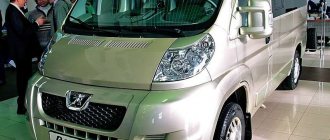Few cars can boast of long-term demand on the world market. Peugeot Partner is one of them. Over its more than 20-year history, the Peugeot heel has gone from a front-wheel drive liter single-volume to a comfortable compact van, ideal for both business and active family vacations and travel. In Russia, the car continues to be popular to this day.
Start of release
In 1996, the French company Groupe PSA introduced the Peugeot Partner “B” segment cargo-passenger van to the market. The new model was designed on the basis of the Peugeot 306, and at the same time, another result of the work of the two concerns Citroën and Peugeot, an absolutely identical copy called Citroën Berlingo, debuted at the Paris Motor Show. The utility of the heel lay in the fact that with rather modest dimensions (4110 x 1720 x 1800 mm with a wheelbase of 2690 mm, ground clearance of 14 cm, R14 wheels, weight less than 2 tons), it had a loading capacity of up to 995 kg, unusual for passenger cars, and transformable luggage compartment that held from 664 to 2800 liters. In fact, with such parameters, this car did not belong to any existing class.
Modifications
Along with the release of a three-door cargo van, a 5-seater passenger version of the Peugeot Combi entered mass production. The classic appearance of the van with a streamlined body, elongated headlights and a narrow radiator grille was complemented by a laconic interior. From the power units, you could choose gasoline with a volume of 1.1 to 1.6 liters (60-109 hp), turbocharged diesel: 1.6-2 liters (75 and 90 “horses”, respectively), and naturally aspirated diesel 1 .9 (69 hp). All options were equipped with a 5-speed manual transmission, independent spring suspension at the front, plus a semi-independent torsion beam at the rear.
Restyling
Peugeot underwent its first update in 2002, receiving a massive bumper painted in body color, larger mirrors, more expressive head optics and taillights, and sliding side doors as an option. The interior of the car has undergone changes, becoming more modern and functional. The interior now has air conditioning, front electric windows, adaptive power steering, heated seats, an information display, cruise control, airbags for the driver and passenger in the base, Isofix child anchorages, numerous compartments for hand luggage, and a 12 V socket.
Design features
Depending on the need, buyers could purchase a van with front-wheel drive or all-wheel drive, a passenger five-seater version of the Combi, or a more comfortable CombiSpace. Access to the interior was provided through both the front and sliding doors. The interior was separated from the luggage compartment by a mesh with a curtain. Folding the rear seats into the floor provided 2.8 m³ of usable cargo space. The weakest liter engine disappeared from the modernized engine line, and the 2-liter HDi was equipped with a Common Rail fuel injection mechanism. In the combined cycle, the car consumed up to 5.8 to 7.5 liters per hundred kilometers, and acceleration to 100 km/h took from 12.9 to 17.5 seconds.
Improved maneuverability
Ushuaia was added to the already existing trim levels , the distinctive features of which were increased ground clearance, crankcase protection, grilles on headlights and lanterns, and a limited-slip differential on front-wheel drive. These options turned the Partner into a full-fledged off-road vehicle.
2.0i (EW10J4)
Years of production: 1999 — 2010
The EW10J4 is a very common 2.0-litre 4-cylinder petrol engine on the aftermarket, as most Peugeot and Citroen car models were equipped with it at one time. Despite existing problems, such as oil waste, which always oozes from under the valve cover, and failures of ignition system components, the engine is not expensive to maintain and is considered quite reliable, and its service life is at least 300,000 kilometers.
Cars equipped: Peugeot 206, Peugeot 307, Peugeot 406, Peugeot 407, Peugeot 806, Peugeot 807, Citroen C4, Citroen C5, Citroen Xsara, Citroen Xsara Picasso
II generation
The next generation of Peugeot Partner was presented to the public in January 2008. The compact van has not just undergone external changes, but has become a completely new model on the universal PSA platform. It has noticeably grown in size: by 24 cm in length and 13 cm in width, which determined its increased load capacity with a luggage compartment of up to 3.3 m³. Numerous niches and pockets in the cabin (on the front panel, in the doors, under the seats, above the windshield) made it possible to transport the maximum number of things. At the same time, without losing its cargo qualities, the van has become more comfortable due to excellent sound insulation and equipping the rear suspension with a beam with springs and shock absorbers, like on a passenger vehicle.
Power units
With the new generation of Peugeot Partner, the 1.4-liter engine was replaced by a 75-horsepower 1.6-liter turbodiesel. Also included were petrol and diesel units with a capacity of 90-110 hp.
Peugeot Partner Tepee
The updated Partner passenger configuration was renamed Tepee (from English “wigwam”). The “talking” name indicated a car created specifically for active recreation and travel with the whole family. The bright and current appearance has not lost recognition thanks to its features. Standard equipment includes 2 front airbags, central locking, power windows, audio unit, anti-lock braking system (ABS), emergency brake assist (AFU).
The standard line of engines in the cargo version in the passenger version was supplemented by one of the latest developments of the concern - HDi 1.6 with 110 “horses” with a particulate filter. This combination made the unit 30% more productive and economical than its analogues. As a rule, it was installed on the “off-road” modification of Tepee Outdoor with crankcase protection, increased ground clearance, and R16 wheels.
Reliability and capacity
Peugeot underwent another restyling in 2012. It not only received an expressive radiator grille, teardrop-shaped headlights, rectangular taillights, an updated nameplate and fashionable hubcaps, but also “grew” in size. An increase in length by 24 cm (wheelbase was 2730 mm) and width by 8 cm made it possible to increase the cargo compartment, the volume of which now started from 675 liters. The rear door glass was made to open, which made loading long items much easier. At the same time, the car has become more maneuverable and controllable.
In the Partner Tepee version, instead of three, there are two seats in front. There are adjustments to the steering column for height and reach. Options include 6 airbags, a tire pressure sensor, exchange rate stability system (ESP), and a panoramic roof.
The changes also affected the technical component. The range of power units consisted of 1.6-liter gasoline (90 and 110 hp) and diesel (75, 90, 110 hp) engines complete with a manual transmission. The lack of dynamism was compensated by modest fuel consumption - up to 8 liters in the combined cycle.
Facelift
In 2015, Peugeot once again updated both versions of the heel. Although externally similar, the architecture of the Peugeot Partner VU van was significantly different from the passenger one. Exterior changes affected the impressive hood, front bumper, spectacular LED optics and radiator grille. The noble appearance is complemented by stylish fog lights and lines of daytime running lights. the icon was moved to the radiator grille.
Professional Partner
The reinforced Partner VU platform could be made in three load capacity options: 625, 750 and 850 kg, and two cargo compartment lengths: L1 Court (1,800 mm) and L2 Longue (2,050 mm). The engine range includes 90-horsepower gasoline and 1.6-liter diesel engines, coupled with a 5-speed manual transmission. The variety of variations made it possible to choose the most suitable commercial transport for the needs of entrepreneurs.
Already in 2016, Peugeot Partner received the title of “Commercial Vehicle of the Year” according to the magazine “L'Automobile et l'Entreprise”. The winner was determined by representatives of thematic media and transport departments.
Comfort inside
Partner Tepee has transformed from a utility compact van into a comfortable, modern and reliable car. On the domestic market it was presented in three trim levels:
- The standard Active is equipped with halogen headlights, two airbags, air conditioning, a driver's seat with height adjustment, full power accessories, an audio system with MP3, AUX and 4 speakers. The car is equipped with sliding side doors, metal crankcase protection and R15 steel wheels.
- Outdoor stood out for its heated front seats with armrests and individual backrest tilt adjustments, and the ability to dismantle the last row. The interior has been replenished with a new MirrorLink multimedia system with a 7-inch screen, Bluetooth, USB, optional navigator and rear view camera. The “Improved cross-country ability” package included increased ground clearance, reinforced suspension, and R16 tires.
- The Allure is equipped with LED headlights, fog lights with Corner light, dual-zone climate control, a leather steering wheel, rear seats that fold in a 1/3-2/3 ratio, a parking assistant and a whole range of active safety devices. The modular design of the Tipi optionally included a panoramic Zénith roof, a fifth door with a hinged window and removable third-row seats, one of which could be freely transformed into a table with cup holders.
Under the hood there could be a 1.6-liter gasoline engine with 110 or 120 horsepower or a 90-horsepower diesel engine paired with a manual or 6-speed automatic transmission. The maximum speed reached 165 km/h, and fuel consumption was 5.7 and 4.6 liters per 100 kilometers.
Among the disadvantages, buyers noted insufficient noise insulation and long warm-up times in winter.
4 stars
Passive safety in the car was ensured by front and side airbags and curtains, belts with pretensioners and limiters, Isofix child seat mounts. The set of active devices included an anti-lock braking system, a dynamic stabilization module, emergency braking assistance, adaptive cruise control, and the Hill Assist function. to maintain a static position of the machine on a slope, intelligent off-road device Grip Control. The final score of the European association Euro NCAP is 4 points for preventing accidents and protecting passengers from injuries.
Maintenance schedule for the Peugeot EP6 1.6 VTI engine
Nefteservis
| Periodicity | every 10,000 km |
| The amount of lubricant in an internal combustion engine | 4.6 liters |
| Required for replacement | about 4.25 liters |
| What kind of oil | 5W-30, 5W-40 |
Gas distribution mechanism
| Timing block type | chain |
| Resource declared | it's not limited |
| Practically | 60,000 km |
| Pause/jump | valve curves |
Thermal play of valves
| Adjustment | not required |
| Adaptation principle | hydraulic lifts |
Replacing consumables
| Air filter | 20 thousand km |
| Fuel filter | 60 thousand km |
| Tank filter | 100 thousand km |
| Candle | 40 thousand km |
| Auxiliary belt | 60 thousand km |
| Fresh liquid | 5 years or 100,000 km |
Electric car
In 2022, at the Geneva International Motor Show, PSA presented the Peugeot Partner Tepee Electric with a range of 170 km. The new product comes standard with all advanced security and multimedia systems. The 7-inch touch display is convenient for telephony and navigation, supported the MirrorScreen function, compatible with Apple Carplay® and Mirrorlink®.
The electric car was driven by an electric motor with a power of 49 kW (equivalent to 68 hp) with a torque of 200 Nm, complete with a single-speed transmission. On both sides of the rear suspension there are capacitive lithium-ion batteries of 22.5 kW/h each. This design solution made it possible to increase the dynamics and maneuverability of the car without losing trunk space. You can charge the batteries either from a standard home outlet or from accelerated half-hour charging according to the CHAdeMO standard.
III generation
At the beginning of 2022, the new generation of the passenger Partner, the Peugeot Rifter, debuted in Europe in five- and seven-seat versions with optional all-wheel drive. The crossvan has an aggressive design: massive wheel arches, an impressive bumper, a trapezoidal radiator grille, and spectacular optics. The body color range includes 8 different shades and several design options for R17 wheels. Rifter is released in 2 modifications:
- Standart with dimensions 4400 x 1850 x 1810 mm, wheelbase 2780 mm and ground clearance of 18 cm.
- Long is 35 cm longer (base is 19 cm).
Interior
The Rifter's interior is designed in the spirit of the i-Cockpit concept, aimed at interaction between the car and the driver. The 8-inch multimedia complex, sports two-spoke multifunction steering wheel and analogue dials are made using high-quality materials. The front seats have pronounced lateral support and a wide range of adjustments. There is enough space in the back row to accommodate passengers with maximum comfort. The trunk volume varies from 775 to 4000 liters, and pockets and shelves with a total capacity of 185 liters are provided for small items. The model is sold in 4 trim levels: Access, Active, Allure and sports GT-line.
Engines
The current year's rifter comes with:
- 1.2-liter PureTech with direct fuel supply function for 110 and 130 hp. Gasoline consumption is about 6 l/100 km.
- 1.5-liter BlueHDi turbodiesel with 75, 110 or 130 hp. with economical fuel consumption of about 4.5 liters per “hundred” kilometers.
The transmission is a five- or six-speed manual transmission or an 8-speed automatic transmission.
Van
The main innovations of the van, which is externally and internally similar to its passenger counterpart, are the luggage compartment reload indicator and the Surround Rear Vision camera, which displays “dead” zones on the screen. A wide range of modifications and options, coupled with a stylish exterior, deservedly earned Peugeot Partner the prestigious title of “International Van of the Year 2019” even before entering mass production.
Prospects in Russia
Demand for Peugeot Partner in our country has remained consistently high throughout all generations of the car. Its cutting-edge design, unprecedented transformation potential and ability to adapt to any commercial need have made this model indispensable for many entrepreneurs and lovers of an active lifestyle.
There is currently no information on the delivery date for the Russian market of the 3rd generation Peugeot Partner.
Liked? Tell your friends:
Engine number
The DV6 engine code is stamped on the cylinder block to the right of the generator, the example is based on the DV6TED4 engine shown below:
When registering, inspectors often ask that the engine code area be clear.
Peugeot 1.6 liter engine characteristics
- Working volume - 1587 cm3
- Number of cylinders - 4
- Number of valves - 16
- Cylinder diameter - 78.5 mm
- Piston stroke - 82 mm
- Timing Belt - Belt (DOHC)
- CV power (kW) - 109 (80) at 5800 rpm per minute.
- Torque - 147 Nm at 4000 rpm per minute.
- Maximum speed - 190 km/h
- Acceleration to the first hundred - 10.6 seconds
- Fuel type: gasoline AI-95
- Compression ratio - 10.8
- Fuel consumption in the city - 10 liters
- Fuel consumption on the highway - 5.8 liters
- Combined fuel consumption - 7.4 liters
In combination with this power unit, the Peugeot 307 can be found with a 5-speed manual or a 4-speed hydromechanical automatic.
Sources
- https://motorist.expert/peugeot/16-hdi.html
- https://kvadrocikly-stels.ru/moto-brendy/dvigatel-er6.html
- https://autohack.net/dvigateli-peugeot/
- https://otoba.ru/dvigatel/peugeot/ep6.html
- https://vvm-auto.ru/peugeot/795-dizelnye-dvigateli-peugeot
- https://motor-zver.ru/avtobrendy/ec5-dvigatel-otzyvy.html
- https://autostrong-m.ru/post/1-6-litrovyj-dvigatel-ep6-mini-n12
- https://autoclub99.ru/2017/06/pezho-307-dvigatel-1-6-litra-xarakteristiki-ustrojstvo-grm/
- https://remontpeugeot.ru/dvigateli-pezho/tu5jp4.html
- https://toyota-chr2.ru/proizvoditeli-i-marki/dvigatel-ec5-115-ls.html
